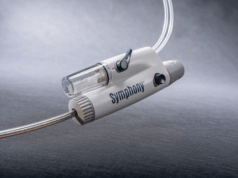
A STRIKE-PE interim analysis of clinical outcomes of acute pulmonary embolism (PE) patients with or without syncope—an indicator of compromised cardiac output and so increased short-term mortality—has found that patients with syncope who had a higher right/left ventricle (RV/LV) ratio at baseline were restored to a condition similar to patients without syncope following treatment with the Lightning Flash (Penumbra) computer-assisted vacuum thrombectomy (CAVT) device.
“Syncope is a frequent conundrum,” said John Moriarty (University of California Los Angeles, Los Angeles, USA) during his late-breaking presentation at the Society of Interventional Radiology (SIR) annual scientific meeting (29 March–2 April, Nashville, USA). “Often we are uncertain whether this is a group of patients with acute intermediate risk, or whether they are within a worse group when considering outcomes or at higher risk of [repeated] intervention, so we felt it was important to study this patient cohort,” he stated.
Initially powered to evaluate 600 patients, the STRIKE-PE cohort was extended, subsequently enrolling 1,500 patients. The prospective, international, multicentre study included patients with acute PE symptoms of ≤14 days and an RV/LV ratio of ≥0.9. Patients from this interim analysis with (n=72) versus without (n=228) syncope were compared.
Moriarty highlighted that there was a statistically significant difference in Miller score of those ≥12 (91.7% vs. 80.7%, p=0.03) in the syncope cohort, taking this to demonstrate a large clot burden, which was seen more frequently in patients with syncope than in those without. These patients also presented with a shorter time from symptom onset to venous puncture (47.5 hours vs. 81 hours p=0.04), and a higher RV/LV ratio (1.48 vs. 1.37, p=0.03).
At 48-hour post-procedure follow-up, RV/LV ratio improved in both groups, however improvement was significantly greater for patients with syncope (0.51 vs. 0.37, p=0.004; 31.7% vs. 25.2%, p=0.002). No significant difference was found between the groups for rate of composite major adverse events within this timeframe, nor concerning 30-day mortality.
“In other words, by imaging characteristics, [patients with syncope] got better, although both cohorts did well,” Moriarty told SIR 2025 delegates. “When we look at safety, there are essentially no differences between the patients who had syncope and those who didn’t. Again, this is—we think—going to be clinically important because there has been a theory that patients who present with syncope are at increased risk, whether it’s primary safety or device-related safety outcome during the procedure.”
Both groups had reduced dyspnoea via the Borg scale at rest from baseline to discharge, and no significant differences in dyspnoea were reported between the groups following a six-minute walk test at discharge.
“Syncope is a common problem,” Moriarty described. “We believe that it’s an indicator of compromised cardiac output, and then therefore it portends to people who have a bad outcome due to the severity of their haemodynamic instability or right ventricular outflow tract obstruction, with an increase in RV dysfunction at presentation, an increase in short-term mortality and risk of early PE-related adverse outcomes, making this is a very fertile area of evaluation,” he added.
“So far, we believe that the clinical benefits of CAVT that are shown in this study may be especially valuable for patients who present to this theoretically high-risk cohort,” Moriarty commented. Moving forward, he and his team add that there is need to elucidate clinical markers to further the understanding of patients with acute PE.










